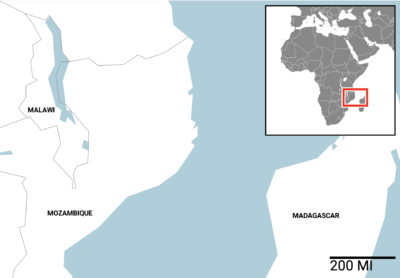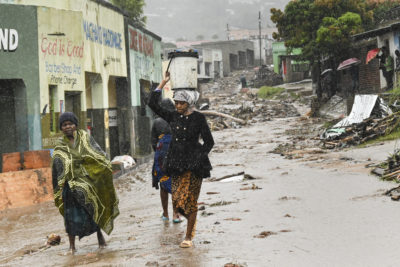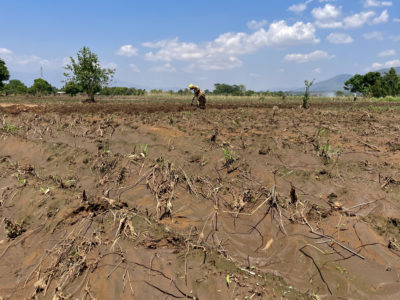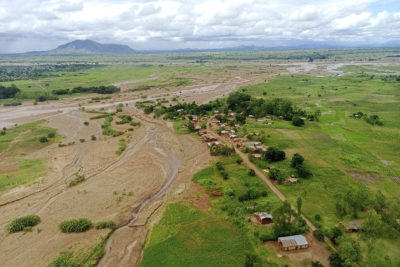It takes Ellen Sinoya, 43, two days to walk to work. She leaves her three children with their grandmother at home in Mwenye, a small village in southern Malawi’s Machinga District, then hikes across the border into Mozambique, stopping only to sleep by the side of the road. After working for a piece rate on a commercial farm for two or three days, she brings home 5,000 Malawian Kwacha ($3.00) — enough to feed her family on maize bran for two weeks. Then she makes the long walk again.
A year ago, Sinoya grew maize and rice on her own one-hectare farm, just yards from her doorstep. But in March 2023, Cyclone Freddy, the strongest tropical cyclone ever recorded, destroyed her home and land.
“I had to abandon my home,” says Sinoya. She returned in August, after living for five months in an evacuation camp, only to find her lands saturated by water. “We cannot grow rice this year because the water has ruined the land. We cannot grow maize because the soil is contaminated with sand. Nowadays, I depend on mangoes, or else we eat kalangonda beans, but these are poisonous unless you cook them well. Every day I worry what my children will eat.”
Cyclone Freddy dropped six months of rainfall in six days, triggering floods and mudslides that killed more than 1,200 people in Malawi.
Cyclone Freddy lasted a record 38 days. The storm barrelled 5,000 miles across the Indian Ocean, pummelling Madagascar and Reunion before striking the African mainland. It swirled over southern Mozambique and Zimbabwe, re-intensified over the warm waters of the Indian Ocean, then returned to strike northern Mozambique and Malawi.
In Malawi’s densely populated southern region, Cyclone Freddy dropped six months’ worth of rainfall in six days, triggering floods and mudslides that killed more than 1,200 people and displaced 659,000. The government’s Post-Disaster Needs Assessment claims total loss and damages exceeded $1 billion. More than 2 million farmers lost their crops as 440,000 acres of land were destroyed or washed away, and 1.4 million livestock were drowned, starved, or lost.
Malawi is among the five nations, worldwide, most affected by extreme weather events, according to the Global Climate Risk Index. The country experiences distinct wet and dry seasons, so climate phenomena like El Niño can disrupt normal rain patterns and lead to periods of drought. Its proximity to the Indian Ocean also makes it susceptible to cyclones and heavy rain. Poverty and deforestation exacerbate these weather impacts for the nation’s smallholder farmers, who produce 80 percent of the food consumed in Malawi.
Eight months after the cyclone dissipated, Malawi’s food system is still reeling. “[Cyclone Freddy] caused soil erosion and degradation,” says Paul Turnbull, the World Food Programme’s (WFP) country director in Malawi. “This has not only affected the 2023 harvest but also has long-term consequences on the productivity of agricultural land. Soil erosion diminishes soil fertility and can lead to decreased crop yields. Some of the affected households have had to wait for another farming season to grow food.”
Many of those affected by Cyclone Freddy still lack a reliable source of food or income, and low agricultural output has also led to food shortages and increased prices nationwide. The price of maize — Malawi’s staple food — has quadrupled in the past 12 months, with a 50-kilogram bag now costing up to 36,600 Kwacha ($21.76). According to the Integrated Food Security Phase Classification (IPC), 4.4 million Malawians will require food assistance before March 2024, a 15 percent increase from last year.
Women like Ellen Sinoya — who make up 50 to 70 percent of the agricultural labor force and are often additionally tasked with caring for children and the elderly — are not only most at risk, they also shoulder most recovery efforts.
Unable to farm their fields, women walk miles in search of stretched humanitarian aid or government handouts.
“Women are the backbone of every society in Malawi,” says Caleb Ng’ombo, director of People Serving Girls at Risk, a nongovernmental organization working to reduce the vulnerabilities of young women and children to sexual exploitation. “Those doing the manual work on the farm are women, those who bring the food on the table are women, and it is women who go and look for food in an emergency.”
And so it is women in the region most affected by Freddy who are now eating less and working even harder to provide for their families. They are surviving off scattered patches of fertile land or walking miles in search of stretched humanitarian aid or government handouts to feed their families. Others have been forced to abandon agriculture for more dangerous work.
“When Cyclone Freddy hit, the number of women in prostitution almost tripled,” adds Ng’ombo. “We have come across so many women whose farmland was washed away. They became so vulnerable, laying hands on whatever they could get to survive and feed their families. It’s become easier for traffickers.”
In Mwenye, Sinoya stands on the ruins of her home, where old clothes and broken plates are still mixed in with the rubble and dirt. “We have nothing to make here. We have nothing to sell. We have nothing to sustain our lives,” she says.
When Cyclone Freddy arrived, Malawi had barely recovered from its last major disaster. In January 2022, Tropical Storm Ana killed 46 people, and more than 190,000 lost or fled their homes. Six weeks later, Cyclone Gombe killed seven people. As stormwaters spread human waste into lakes and wells, Malawi’s ongoing cholera outbreak, the largest in the nation’s history, worsened.
Rural villages, including Mwenye, were vulnerable to disease and disruption long before Freddy hit. More than half the nation lives in poverty, and one-fifth live in extreme poverty, which forces people to make high-risk decisions. According to the WFP, approximately 73 percent of Malawians live in areas prone to climate-related disasters, including floods, drought, cyclones, and windstorms. “It’s difficult to afford a plot or rent a house, so poverty is leading people to settle in hazardous places,” says Miriam Joshua, an associate professor of geography and earth sciences at Malawi University. “They are afraid of moving to [safer] areas where there may be no livelihood.” For the same reason, early warning systems — which do not always reach the most rural areas — have had little impact.
Sitting on the banks of a river that runs off the base of a mountain, Manja Village, in Machinga District, has always been flood prone. It’s also a place where poverty, land degradation, and agricultural dependency have compounded residents’ risk.
Climate change could force Malawi, already highly vulnerable, into a constant state of response and recovery.
The men in Manja cycle from the hillside with bags of charcoal tied to their bikes. Nearly every Malawian household relies on firewood and charcoal for cooking and heating, so selling charcoal is one of the few businesses that provide a guaranteed source of income.
But this has led to massive deforestation: by 1992, Malawi had lost more than half its forests, and it now loses an additional 0.63 percent annually. As the land loses its capacity to absorb water and as soil erodes, vast areas have become increasingly vulnerable to floods and mudslides.
Enipher Jailosi, 35, was waiting to plant maize after Cyclone Freddy swept through her village, but in October, one month before the rainy season usually arrives, heavy rains hit the hillsides. Floodwaters rushed into Manja, destroying 84 houses and breaking through a newly built dike, pushing gravel into the soil and turning recently planted farmland into bare, muddy fields.
She points to a plot covered in the wilted remains of maize, where she is slowly removing gravel with a hoe so she can start cultivating her farm once again. “I need this land to feed my children, but my crops can’t grow on this soil now,” Jailosi says. “This is only the first rains, so what will happen in December and January?”
With all of Malawi’s existing vulnerabilities, an event of Freddy’s magnitude was more than enough to push an impoverished population over the edge. Now, climate change threatens only more of the same, forcing Malawi into a constant state of response and recovery.
Enrico Scoccimarro, a senior scientist at the Euro-Mediterranean Centre for Climate Change (CMCC), has warned that a warmer climate will cause tropical storms to become more severe as ocean temperatures rise. “A higher availability of energy in the ocean leads to more intense storms,” Scoccimarro told the CMCC’s Foresight magazine. “Moreover, if a storm happens to go back to the ocean, it has a higher probability to re-strengthen and hit land again, and this is just what happened with Freddy recently.”
“The southern part [of Malawi] lies in the area where cyclones usually pass and the Coriolis effect is stronger,” says Lucy Mtilatila, director of Malawi’s Department of Climate Change and Meteorological Services. “Sea temperatures are also increasing, creating opportunities for more and stronger cyclones. Malawi used to experience one cyclone every seven years, but we have experienced five since 2019. As long as temperatures keep increasing, we anticipate more extreme events in the future.”
Subsistence farmers can’t be expected to break from centuries of convention without training, subsidies, and incentives.
Of course, massive investment in response and recovery would mitigate the impacts of these events, but Malawi is a poor nation. The government predicts that climate change, in a business-as usual-scenario, could result in a 20 percent loss of GDP by 2040; meanwhile, the population is projected to almost double by 2050.
“It’s not like we don’t know what we should do,” says Chipiliro Raymond Khamula, a spokesperson for Malawi’s Department of Disaster Management Affairs. “There are many disaster risk reduction interventions that should be implemented, [including] early-warning systems, reforestation, and relocation programs.” The major challenge has been funding. “The country will require at least $1.9 billion to reduce risks, recover, and build resilience,” Khamula says.
Clearly, preserving and adapting Malawi’s food systems must be a priority if the nation is to withstand the crippling impacts of climate change. This, at least, can be done at a lower cost.
Currently, 85 percent of the population depends on rainfed agriculture, and so lives are intricately linked to seasonal rainfall that is becoming increasingly erratic. But some farmers are adapting.
Jacob Jumpha, 26, lives on the banks of Lake Malawi in Mangochi District. Like many smallholders, he owns just one hectare, but half of that was turned to marsh when rainfall elevated the lake by 1.5 feet in 2022.
The path of mudslides brought on by Cyclone Freddy in Mulanje District, Malawi.
Jack McBrams / AFP via Getty Images
But Jumpha survives thanks to his adoption of relatively low-cost farming methods that have improved his resilience to climate shocks. He now grows peas between rows of maize, which increases yields during periods of high rainfall and reduces soil nutrient loss. Instead of using chemical fertilizer, whose price soared after Russia’s invasion of Ukraine, Jumpha uses compost and manure, which improves water retention during the dry season. Though he still struggles with the impacts of flooding, Jumpha continues to make a living and even harvests throughout the dry season, when most smallholders cannot.
Farming methods like these are accessible to millions of Malawians and would be advantageous even without climate change. But most people never learn about these techniques, or they resist change. Subsistence farmers can’t be expected to break free from centuries of convention, experts say, without structural support like training, subsidies, and incentives.
NGOs currently provide some of that training, and in June, Malawi secured $4.4 million in funding from the Global Environment Facility’s TRANSFORM project. Supported by the United Nations Development Program, the five-year project aims to reduce exploitation of natural resources, restore forests, and facilitate the uptake of alternative livelihoods, like mushroom cultivation and beekeeping.
Such strategies are promising, but they have yet to reach the most rural villages. Helping Malawi’s most vulnerable communities — which include people like Ellen Sinoya, whose land may be unproductive for some time to come — will be crucial for those recovering from Cyclone Freddy, and from the inevitable disasters of the future.




